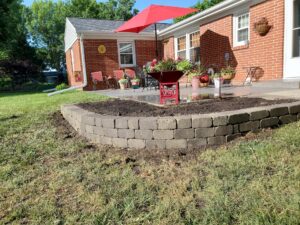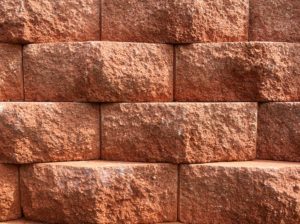Retaining walls in Des Moines landscapes have a variety of uses, including soil stability and aesthetics. As little as 15 years ago, retaining walls had very limited options in terms of quality and visual characteristics. Today, many manufacturers make retaining wall block that come in various shapes and sizes as well as multiple colors.
Retaining Walls and Soil Stability
It is crucial to follow the manufacturer’s instructions when building a retaining wall for soil stability. Failure to do so can result in a wall that could fall over or be a hazard to your home. Properly built retaining walls have many critical characteristics which are essential for stability but may not be seen in the final product. This is similar to walls of a house; each wall can have plumbing and electrical wires in it which are crucial to your home, but you never see those items since they are usually covered up by drywall. A properly built retaining wall should be built on a pad of crushed aggregate, have a drainage system behind it, be backfilled with the proper aggregate, and in some cases should have geo textile fabric embedded in it.
The first step in building a retaining wall is to assess the site conditions and decide how tall the wall should be and how long it needs to be. At this stage, it is also important to determine if the proposed retaining wall is going to be holding earth back or if is going to be for decorative purposes only. For retaining walls that are going to be structural, knowing the final height will determine how deep the first course of the wall needs to be buried in the ground. Since the first course of the wall will be holding all the weight of the subsequent top layers, we want to make sure that the bottom layer has front stability to keep it from bowing out.
After the height has been determined and the depth of the first course has been decided, excavation of the wall can begin. The excavation of the wall should continue at least six inches below the bottom of the first course of retaining wall block. This will allow for adequate depth of base stone which the wall will be built on.
One-inch roadstone is the most common foundation for retaining walls in central Iowa. Roadstone is widely available and compacts very well to provide a solid base for the wall to be built on. After the exaction is complete and the base has been added and tamped, wall construction can begin.
If the wall is going to be straight, it is easiest to put a stringline up from end to end. As the blocks are being installed, you can keep the wall straight by keeping the block touching the wall. Since most retaining wall block have a rough face, it is usually easiest to put the stringline on the back of the block. For walls that will have curves on them, you can measure the angles of backs of the retaining wall blocks or spray paint a line to follow on the base to ensure the curve is where it is supposed to be.
Level Retaining Walls
When leveling the retaining wall blocks, having both a torpedo level as well as a two- and four-foot level works best. Ensure that the block is level from front to back as well as side to side. Use the two-foot level to ensure that the touch blocks on the left or right as also level with each other and also use the four-foot level to check the same.
After the fist layer is laid, the back of the wall to the top of the retaining wall block should be filled with roadstone and compacted. When compacting, make sure not to hit the block or make the block move forward as this can cause the final wall to not be level or straight.
On top of the compacted roadstone behind the wall, place a perforated drain tile so that the drain tile is against the second layer of block and on top of the compacted roadstone. The drain tile should have an exit point in the face of the retaining wall. There are multiple types of retaining wall drains that can be purchased. We like to use a product called a Wall Drain Pro which has a slim design and it almost not noticeable in the face of the wall if installed properly.
After the first layer is in place, the subsequent layers of the retaining wall can now be stacked on each other. Stack each block so the center of the block is halfway on two blocks below it. This will create a wall that has great structural integrity. After each layer, the wall should be backfilled with one-inch clean limestone.
Retaining Walls and Water

Walls that are taller than four feet or walls which are holding enormous amount of earth back, should be installed with geosynthetic material, also called geo-grid. Geo-grid will get installed between layers of the retaining wall and will extend back into the hillside. The taller the wall, the further back in the hillside the geo-grid should extend. Geo-grid acts as a soil stabilizer behind the wall. This soil then gets tied into the grid and connected to the wall creating a heavy mass to help resist soil pressure up-slope and behind the wall. When using geo-grid, the grid should extend through the clean backfill and into the soil. Make sure to compact each layer of soil and drainage aggregate between each layer of geo grid.
The last step of retaining wall construction is to add a cap. The cap is the top layer of the wall and in most cases is the only portion of the call that is connected with adhesive. Since most retaining wall block are trapezoid shaped, the cap will act as a solid top layer and will fill in the gaps on the back of the retaining wall block. The cap will also help keep debris such as leaves and mulch from entering the drainage aggerate which is behind the wall.
While building a retaining wall seems like an easy task in concept, there are a lot of hidden factors that go into constructing a wall that is safe and will last. When looking for a landscape contractor to build your retaining wall, cost savings might not always be the best option. In the Des Moines, Iowa landscape market, we have seen countless walls that have been constructed improperly. We have seen contractors place the bottom course directly on the soil and backfill walls with compacted soil. While cheap for the homeowner, it almost always costs more in the long run to reconstruct the wall after it fails. If you are looking for a contractor who will do the job right on day one, contact us at TeBock’s Landscape.
Preferred Retaining Wall Products in Des Moines
While there are a wide variety of landscape retaining wall products on the market, there are a few that we prefer to use on our landscape jobs. For concrete block walls, our go-to product is the Versa-Lok line. Versa-Lok is a solid landscape block and uses a system of pins to interconnect each block. Other types of retaining wall block are not solid and instead filled with rock as each layer of the block is built. Versa-Lok sold in the Des Moines market comes in up to six colors. The colors can be either plain (tan and gray) or mixed (swirled variations of color in each block). Versa-Lok is most used as a rough face straight retaining wall block. This provides a clean look in landscapes. Other brands of retaining wall blocks have beveled faces and do not look nearly as clean.
Another type of retaining wall block we like to use is a product that goes by the name of ledgestone or riverland wall block. This is a shorter block that measures 4x8x12 usually. The most common use of this block is for seating walls, fire pits, fireplaces, outdoor bars, outdoor kitchens, pizza ovens, and garden walls. This type of block is not suited for large structural retaining walls where a lot of earth is being held back. This tends to be a more decorative type of block. When constructing walls and outdoor structures, the same type of site preparation goes into this wall as a Versa-Lok wall. The only major difference being that this wall gets glued together with a concrete adhesive between each layer.
For homeowners who are looking for a more natural approach for retaining walls in their yards, Midland concrete products makes some great looking, pre-cast stone that is molded to resemble natural stone. They have a couple of wall materials that we like including Kodah wall and Rosetta outcropping walls. This stone comes in a couple of colors to mimic natural stone; a buff-cream color and a gray color.
Kodah wall resembles limestone pieces that are long and narrow. The Rosetta walls are large chunks that resemble cliff like walls in natural elements. We prefer to use these pre-cast stone over real stone for many reasons. One reason is time of install. Since a large portion of any landscape project includes labor, having materials that are easy to work with can save time.
Both types of walls have specific layouts vs. natural stone, a large portion of time is spent try to fit so the seams are as tight as possible. In many cases, a lot of time is spent chiseling natural stone to achieve a tight fit. We also like the Midland products because they are engineered, and we know what the capabilities of each stone are. With natural stone, there can be variations in height and weight which can make construction more difficult.
Lastly, with the Midland products, since they are a concrete based product, they are going to be less likely to fade over time. Natural stone tends to fade quicker than concrete products do.
If you need a retaining wall built in the Des Moines or central Iowa area, give us a call at 515-809-0690, or send us a message here. By choosing us, you have our guarantee that your retaining wall will be properly built and built to last.




